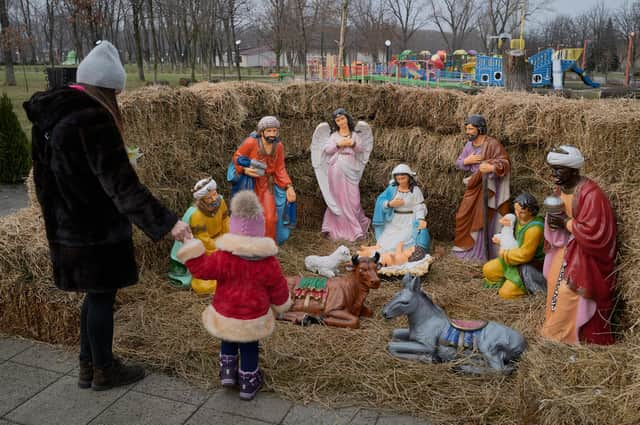Ian Ellis: We can let the Christmas story give rise to wonder in our souls


Nativity plays, perhaps as part of church services or in school assemblies, try to bring together the different elements of the scriptural accounts through acting them out in a short presentation.
Family members and friends especially enjoy seeing their young children taking part in these dramas, complete with appropriate costumes.
Advertisement
Hide AdAdvertisement
Hide AdI remember once having a nativity play in my parish church, in which a recently born baby took the part of the infant Christ. It was a delightful and very memorable occasion.
Yet these scenes are not just to be observed but also are to give rise to deeper reflection about what Christmas is all about.
Bible reading is to be accompanied by such a reflective process, perhaps helped by an elucidating sermon or by a written commentary to which those studying scripture may turn for further insights.
From ancient times, scripture has been treated in such ways.
Advertisement
Hide AdAdvertisement
Hide AdThe Bible is a whole and the right way to approach the most perplexing parts of it is to look at them in the context of the full sweep of the scriptural witness.
It requires effort, even at times a wrestling with the text.
Of course, whether at Christmas or at any other time of the year, the preacher is not there simply to tell people what they want to hear, but is there to present the scriptural message in a way that can both challenge and appeal.
Indeed, the appeal of the Christmas narrative in the Bible is undoubtedly very broad, bringing so many people out to church even at the midnight hour.
Advertisement
Hide AdAdvertisement
Hide AdWe may not understand the virgin birth or the appearance of angels, but we can allow such narratives to give rise to wonder in our souls, speaking in their own way of the divine nature and destiny of Jesus and of a heavenly and spiritual reality that surpasses all human comprehension.
None of us can ever know everything about God, nor can we ever define everything about God in words, but we can allow ourselves to wonder deeply and to be moved in faith and to faith.
The incredibly happy story of Christmas is a story of God's loving purposes and the scenes in that story invite us to delve more deeply into the things of life and the things of God.
The stable at Bethlehem, the shepherds out there on the hillside, the magi from the east coming to worship the Christ-child, the guiding star in the sky – these are perhaps the most frequently depicted scenes on Christmas cards cheering up our homes.
Advertisement
Hide AdAdvertisement
Hide AdThe stable tells of the desperate need of Mary and Joseph to find a place to stay and of the way in which one particular innkeeper would not see them stuck.
He gave them what he could.
Yet, as well as challenging each of us to give what we can to others in need and to make room for Christ in our lives, the stable tells of God visiting his whole creation, because here in the stable there are animals too, themselves helping to keep the little, holy family warm in the deep mid-winter.
Moreover, the simple manger in which the infant Jesus rests testifies to how Christ comes in the lowliest way.
We are thereby told that this birth is for everyone, regardless of the individual's standing in life.
The shepherds can be taken to represent the public.
Advertisement
Hide AdAdvertisement
Hide AdHere are ordinary people, doing their everyday work yet being made aware of something unique and transcendent happening.
The angelic announcement of the good news to the shepherds represents the making public of the news of Jesus' birth.
The angel also tells them not to be fearful at the magnitude of what was happening: “Fear not: for, behold, I bring you good tidings of great joy, which shall be to all people.”
An angel is understood to be not only one of God's heavenly attendants but also a messenger of God.
Advertisement
Hide AdAdvertisement
Hide AdThe angel comes to the shepherds with the glad news of the birth of the one who would be the saviour of the world.
Salvation contains the idea of healing, and this saviour comes to bring his healing touch to every life and to the whole world.
The magi, learned and wise men, follow a star which leads them to the stable, above which it rests.
While it is difficult to see precisely how a star could do such a thing, it is not at all difficult to see that these men were indeed led to make that journey, led to seek the holy child and to realise that, truly, they should not go back and tell Herod where they had found him.
Advertisement
Hide AdAdvertisement
Hide AdIf the announcement of Jesus' birth to the shepherds in a way represents the publishing of the good news of the holy birth, the role the wise men from afar play in the nativity story represents the universality of Christ's reach.
This sacred child has come for the whole world, not for just one people or one nation but for every person and every nation under the sun.
• Canon Ian Ellis is a former editor of The Church of Ireland Gazette